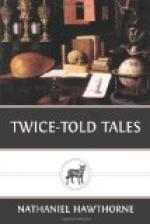“Oh yes,” replied I, who had mused long upon the incident; “and when they rise again, these bitter foes may find themselves dear friends. Methinks what they mistook for hatred was but love under a mask.”
A gentleman of antiquarian propensities provided a memorial for an Indian of Chabbiquidick—one of the few of untainted blood remaining in that region, and said to be a hereditary chieftain descended from the sachem who welcomed Governor Mayhew to the Vineyard. Mr. Wiggles-worth exerted his best skill to carve a broken bow and scattered sheaf of arrows in memory of the hunters and warriors whose race was ended here, but he likewise sculptured a cherub, to denote that the poor Indian had shared the Christian’s hope of immortality.
“Why,” observed I, taking a perverse view of the winged boy and the bow and arrows, “it looks more like Cupid’s tomb than an Indian chief’s.”
“You talk nonsense,” said the sculptor, with the offended pride of art. He then added with his usual good-nature, “How can Cupid die when there are such pretty maidens in the Vineyard?”
“Very true,” answered I; and for the rest of the day I thought of other matters than tombstones.
At our next meeting I found him chiselling an open book upon a marble headstone, and concluded that it was meant to express the erudition of some black-letter clergyman of the Cotton Mather school. It turned out, however, to be emblematical of the scriptural knowledge of an old woman who had never read anything but her Bible, and the monument was a tribute to her piety and good works from the orthodox church of which she had been a member. In strange contrast with this Christian woman’s memorial was that of an infidel whose gravestone, by his own direction, bore an avowal of his belief that the spirit within him would be extinguished like a flame, and that the nothingness whence he sprang would receive him again.
Mr. Wigglesworth consulted me as to the propriety of enabling a dead man’s dust to utter this dreadful creed.
“If I thought,” said he, “that a single mortal would read the inscription without a shudder, my chisel should never cut a letter of it. But when the grave speaks such falsehoods, the soul of man will know the truth by its own horror.”
“So it will,” said I, struck by the idea. “The poor infidel may strive to preach blasphemies from his grave, but it will be only another method of impressing the soul with a consciousness of immortality.”
There was an old man by the name of Norton, noted throughout the island for his great wealth, which he had accumulated by the exercise of strong and shrewd faculties combined with a most penurious disposition. This wretched miser, conscious that he had not a friend to be mindful of him in his grave, had himself taken the needful precautions for posthumous remembrance by bespeaking an immense slab of white marble with a long epitaph in raised letters, the whole to be as magnificent as Mr. Wigglesworth’s skill could make it. There was something very characteristic in this contrivance to have his money’s worth even from his own tombstone, which, indeed, afforded him more enjoyment in the few months that he lived thereafter than it probably will in a whole century, now that it is laid over his bones.




